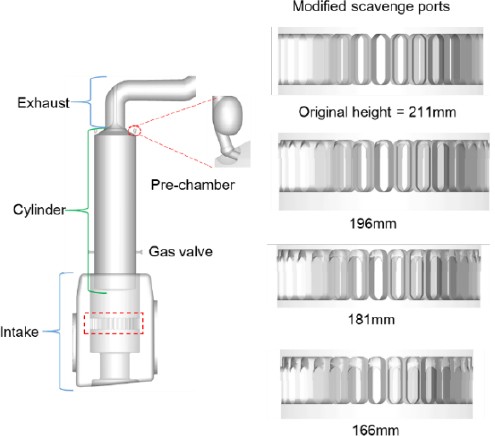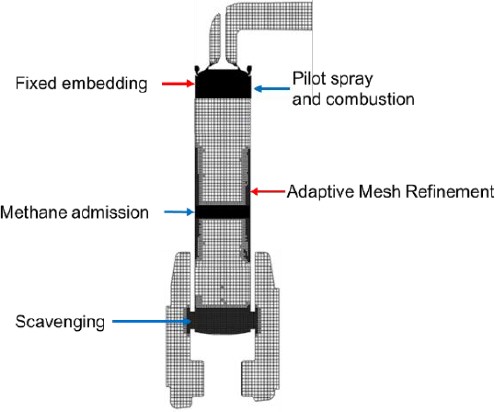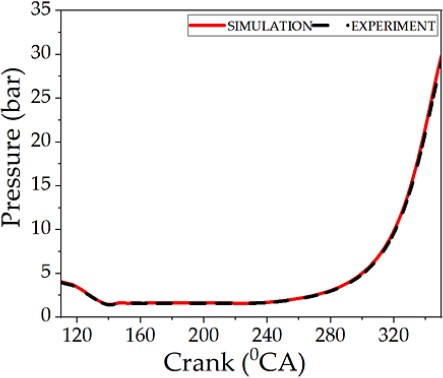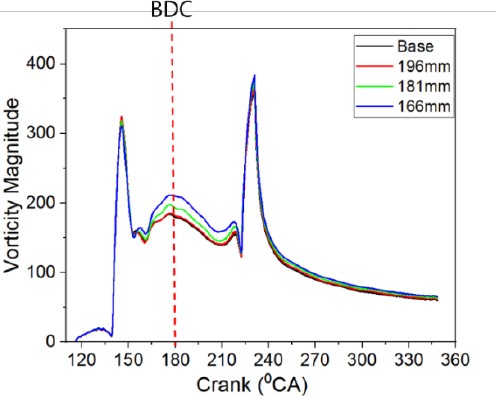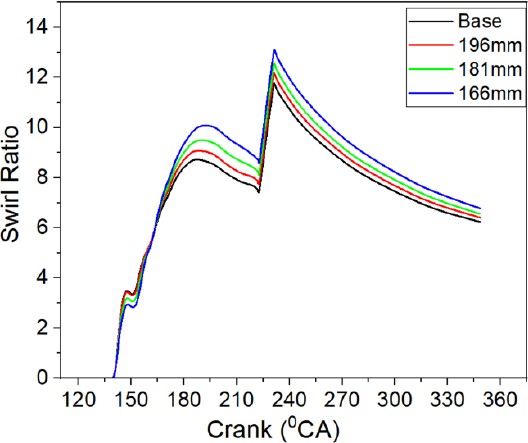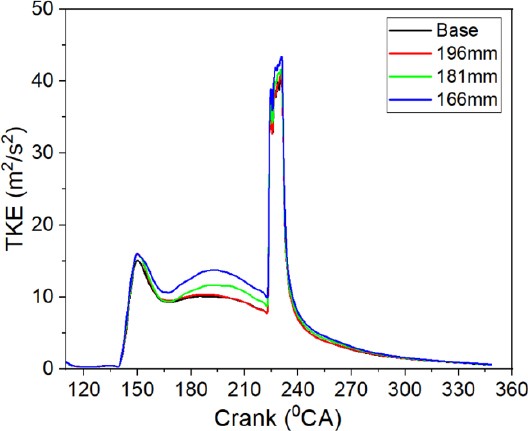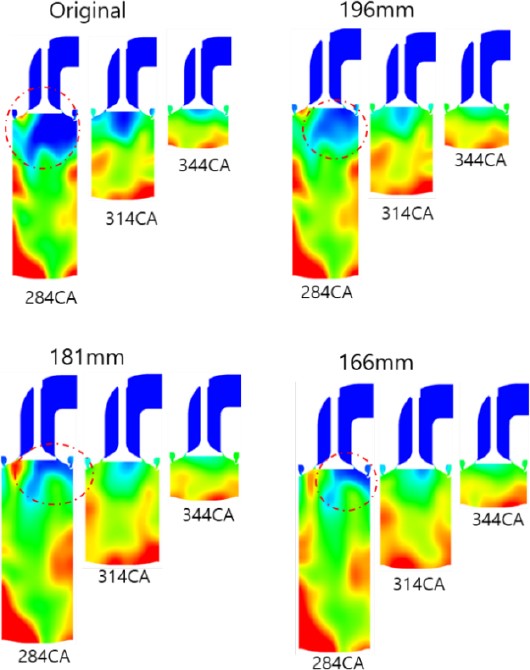
Study on natural gas stratification enhancement in low-pressure natural gas-diesel dual-fuel marine two-stroke engine using CFD approach
Copyright © The Korean Society of Marine Engineering
This is an Open Access article distributed under the terms of the Creative Commons Attribution Non-Commercial License (http://creativecommons.org/licenses/by-nc/3.0), which permits unrestricted non-commercial use, distribution, and reproduction in any medium, provided the original work is properly cited.
Abstract
Natural gas (NG) is a potential alternative fuel for a carbon-free transition. Currently, NG combustion in marine two-stroke engines is achieved using two dual fuel concepts namely, the high-pressure injection (HPDF) and low-pressure injection (LPDF). The LPDF engine concept can meet the Tier III emission regulations without any after-treatment devices. However, under low load conditions, it exhibits poor combustion characteristics and higher CO and HC emissions. The quality of the in-cylinder NG/air mixture is crucial for the premixed combustion nature of the LPDF concept. This study numerically evaluates the influence of adjustable-sized scavenge ports on the NG stratification in a large-bore marine two-stroke NG/diesel, dual-fuel engine. Originally, the engine port height was 211mm; the size was reduced to various port heights to analyze its influence on the NG/air stratification. The results showed a significant improvement in the in-cylinder dynamic, mixing, and turbulence properties. The swirl ratio, turbulence kinetic energy, and vorticity magnitudes were increased to a maximum of 16.56, 37.027, and 17.04%, respectively. However, owing to the reduced scavenge port size, the trapped air mass in the cylinder was reduced slightly by 2.05%. This study provides a reasonable approach to improve the cylinder mixture formation to improve combustion efficiency in marine low-pressure gas dual-fuel engines.
Keywords:
Natural gas, Low pressure injection, Dual fuel, Combustion1. Introduction
Usage of fossil fuels leads to various issues, such as the greenhouse effect, respiratory diseases, and rise in sea levels [1][2]. The shipping activities and marine global trade, which mainly depend on fossil fueled propulsion systems, are also increasing [3]. Therefore, the International Maritime Organization (IMO) has tightened the emissions regulations by introducing the Tier III for NOx emissions, Sulfur cap for SOx, and implementation of the greenhouse gas (GHG) strategy, which aims to attain netzero GHG emissions from international shipping by 2050, and the uptake of zero and near zero GHG fuels by 2030 [4]. In the same GHG strategy, the IMO targets to reduce the carbon emission intensity by 40% by 2030.
Natural gas (NG) is one of the best candidate fuels to lower emissions in internal combustion engines (ICE). It is a cleaner energy source with relatively low price. Furthermore, the NG reserves are vast, which solves the availability uncertainties. However, it is a low-reactive fuel, hence its combustion in IC engines can be achieved using spark ignition or dual-fuel approach, especially in the marine engines [5]. With large-bore marine two-stroke engines, there are two main NG supply modes, the high-pressure injection (HPDF) and low-pressure injection (LPDF). This study is limited to the LPDF concept. Combustion in an LPDF engine is largely pre-mixed and hence has a low combustion temperature, which leads to a substantial reduction in the NOx emissions [6]-[8]. Under low load conditions, the quality of the gas–air mixture becomes poor owing to the reduced airflow and in-cylinder swirl, which leads to poor combustion characteristics, flame extinction in lean regions, and accelerated CO and HC emissions [9]-[11].
Notably, with fixed engine dimensions and parameters, it is challenging to achieve high engine performance over a wide load range. Recently, variable engine parameters approach has been studied extensively to enhance engine performance across various engine loads.
Variable exhaust valve timing has been found to have a significant effect on the fuel efficiency and pumping losses [12][13]. Variable fuel injection has become a common approach to improve engine performance and reduce exhaust gas emissions at various engine loads [14][15]. Furthermore, variable compression ratio has been suggested as a potential approach to improve the fuel economy of engines, especially at part load conditions [16][17]. Variable nozzle turbochargers and turbocharger cut-out approaches have been used in recent years to improve the scavenge air, especially under low load conditions [18]. The scavenging process plays a key role in the in-cylinder mixture formation of an ICE. Reducing the scavenge port size increases the fluid flow velocity across that port region, resulting in higher kinetic energy and improved mixture formation in the engine cylinder. Studies on adjustable scavenge ports approach are rare. Thus, this study aims to investigate the effects of adjustable-size scavenge ports on the in-cylinder NG-air stratification in a marine LPDF engine under low load conditions. 3D cold flow simulations were conducted from the exhaust valve opening (EVO) position to near the top dead center (just before pilot fuel injection) to analyze the in-cylinder fluid flow characteristics in terms of swirl ratio, turbulence kinetic energy, methane distribution, velocity, and vorticity magnitude.
2. Model Description
Cold flow simulations in this study were performed using the CONVERGE CFD software, and the WINGD 6X72DF engine was used to explore the effects of adjustable-size scavenge ports. The 3D computational geometry and changes made on the scavenge ports are shown in Figure 1; the principal dimensions of the engine are presented in Table 1.
The 3D computational domain is composed of five regions, namely the exhaust, cylinder, scavenge, pre-chamber, and gas admission regions. The exhaust region consists of the exhaust valve, exhaust manifold, and exhaust outlet. The cylinder region consists of the cylinder head, liner, piston, and the exhaust valve bottom part. The scavenge region consists of the scavenge box, scavenge ports, and scavenge air inlet. The pre-chamber region entails the PCC, while the gas admission region consists of the gas admission valve.
The lowest engine load selected was 25% based on Annex VI test cycle Type 3 for propeller-law-operated main engine applications. Therefore, to simulate low engine load engine conditions, all the simulation setups and boundary conditions were obtained from the experimental data at 25% engine load. The boundary conditions used in this study are shown in Table 2.
The meshing of the computational domain is critical to achieve accurate results. Engine dimensions used in this study are significantly large, therefore strategic meshing at critical fluid flow regions and relatively larger mesh in the rest of the domain was employed. A base mesh, which is a mesh of the entire 3D domain, was set to 40 mm. However, special mesh refinement known as the fixed embedding of the size range of 5–10 mm was applied at the scavenging region, gas admission region, top cylinder region, and pre-combustion chambers (PCC) to ensure high accuracy.
Additionally, an adaptive mesh refinement approach of size 5 mm was applied to the cylinder and intake region for temperature and velocity, i.e., if the temperature and velocity in the selected region exceeds the set limit, the mesh will automatically be reduced to 5 mm to capture the fluid flow accurately, as shown in Figure 2. The maximum number of mesh attained was 1.5 million cells during the scavenging period and 1.2 million cells during the methane injection.
The simulation model set-up for fluid flow processes inside the combustion chamber involved the Re-Normalized (RNG) k-epsilon based on Reynolds Averaged Navier Stokes (RANS). On the contrary, the wall heat transfer was modeled using the O’Rourke and Amsden models [19]. A preliminary simulation study to validate the 3D computational model was performed from the EVO to 10 crank angle degrees before the top dead center (BTDC). Figure 3 represents the in-cylinder pressure history graph during the scavenging and compression stages.
3. Results
3.1 Effect of Various Port Sizes on In-Cylinder Velocity and Vorticity Magnitude
Figures 4 and 5 show the results of the velocity and vorticity magnitude with different port heights. Reducing the port size at low load leads to increased velocity and vorticity magnitude. Compared to the original case, the velocity magnitude increased especially near the upper cylinder walls, indicating improved fluid flow processes. The vorticity magnitude graphs shown in Figure 5 also indicate a significant improvement, especially at the BDC for various scavenge port heights. Adjusting the port heights to 196, 181, and 166 mm increased the resultant vorticity magnitude by 1.36, 7.54, and 17.040%, respectively. Vorticity is the measure of the fluid circulation inside the engine cylinder. High fluid circulation facilitates the fuel air mixing processes hence, application of adjustable size ports can help to improve fluid flow velocity and vorticity.
3.2 Turbulence Kinetic Energy and Swirl Ratio
Figure 6 represents the in-cylinder swirl ratio for various scavenge port sizes. The swirl ratio is an important fluid mixing parameter. A higher swirl ratio is desired in the IC engines to ensure maximum fuel–air mixing and to assist in flame propagation. Previous research works have confirmed that increasing the swirl ratio resulted an improved thermal and combustion efficiency and lower exhaust gas emissions [21]-[23].
By reducing the size of the scavenge port, the capability to significantly improve the in-cylinder swirl is demonstrated. In the investigated case, the swirl ratio was improved by 4.47, 9.57, and 16.56% at port heights of 196, 181, and 166 mm, respectively.
Similarly, the turbulence kinetic energy (TKE) was improved by applying various scavenge port heights, as shown in Figure 7. The TKE can be used to indicate the measure of the vigor of the fluid particles moving in any fluid domain. Reducing the scavenge port height reduces the overall port area. Therefore, with reference to mass conservation, the velocity through the reduced port size is increased to maintain the continuity equation.
3.3 Effect of Adjustable-Size Scavenge Ports on Methane Distribution
Figure 8 illustrates the methane mass fractions at different crank angles using varying port sizes. At 76 crank angle BTDC, a large region of low methane concentration is observed in the upper region near the exhaust valve. The in-cylinder methane–air mixture becomes more uniform as the scavenge port size is reduced, which reduces the region of low methane concentration. As previously mentioned, the LPDF engine exhibits largely premixed combustion, which is dependent on the nature of the gas/air mixture. Extremely low concentration regions lead to flame extinction, affecting the engine performance; this explains the large cycle-to-cycle variation experienced in the LPDF marine two-stroke engines.
A good NG-air stratification is important to reduce extremely lean regions that interfere with the combustion process, leading to increased levels of unburned methane (methane slip), carbon monoxide, and reduced engine thermal efficiency.
The application of adjustable size ports in the marine LPDF engine shows improvements in cylinder fluid dynamic and mixing characteristics necessary to improve the combustion efficiency.
4. Conclusion
In this study, a numerical study was conducted on a marine LPDF NG-diesel marine two-stroke engine with the aim of enhancing the gas–air mixture characteristics using the adjustable-size scavenge ports strategy. A 25% engine load was employed to depict low-load engine operational conditions. Application of this scavenging strategy revealed a significant improvement in the quality of the in-cylinder gas–air mixture. The fluid dynamic, turbulence, and mixing parameters were improved when the scavenge port size was adjusted. The swirl ratio was improved by 4.47, 9.57, and 16.56%; TKE was improved by 2.15, 16.13, and 37.027% while the vorticity magnitude was increased by 1.36, 7.54, and 17.040% when the port sizes were reduced to 196, 181 and 166 mm, respectively. However, it should be noted that a slight decrease in the trapped air mass of less than 0.6% occurred when the scavenge port sizes were reduced. Thus, the selection of an appropriate port height is significant. These results are important in the development of LPDF gas engines with high combustion efficiency at a wide load range. Future research will incorporate combustion and exhaust gas emission simulations to further expand on the benefits and drawbacks of the proposed strategy.
Acknowledgments
This research was supported by the Autonomous Ship Technology Development Program [20016140] funded by the Ministry of Trade, Industry, & Energy (MOTIE, Korea); and the ‘Technology development Program [G21S336623801]’ funded by the Ministry of SMEs and Startups (MSS, Korea).
Author Contributions
Conceptualization, Methodology, Software, Validation, Formal Analysis, Investigation, Data Curation, Writing—Original Draft Preparation, A. J. Nyongesa; Formal Analysis, Investigation, Data Curation, J. K. Kim; Conceptualization, Validation, Resources, Writing—Review & Editing, Supervision, Project Administration, Funding Acquisition,W. J. Lee.
References
-
G. Chehade and I. Dincer, “Progress in green ammonia production as potential carbon-free fuel,” Fuel, vol. 299, p. 120845, 2021.
[https://doi.org/10.1016/j.fuel.2021.120845]

-
A. Yapicioglu and I. Dincer, “A review on clean ammonia as a potential fuel for power generators,” Renewable Sustainable Energy Reviews, vol. 103, pp. 96-108, 2019.
[https://doi.org/10.1016/j.rser.2018.12.023]

-
L. Huang, Y. Wen, X. Geng, C. Zhou, and C. Xiao, “Integrating multi-source maritime information to estimate ship exhaust emissions under wind, wave and current conditions,” Transportation Research Part D: Transport Environment, vol. 59, pp. 148-159, 2018.
[https://doi.org/10.1016/j.trd.2017.12.012]

- International Maritime Organization (IMO), https://www.imo.org/en/OurWork/Environment/Pages/2023-IMO-Strategy-on-Reduction-of-GHG-Emissions-from-Ships.aspx, , Accessed on December 7, 2023
-
M. Ishida, T. Tagai, H. Ueki, and D. Sakaguchi, “Ignition and combustion characteristics of methanol mixture in a dual fuel diesel engine (Diesel engines, performance and emissions, intake gas treatment), The Proceedings of the International Symposium on Diagnostics and Modeling of Combustion in Internal Combustion Engines, vol. 2004.6, pp. 51-58, 2004.
[https://doi.org/10.1299/jmsesdm.2004.6.51]

-
L. Liu, Y. Wu, and Y. Wang, “Numerical investigation on knock characteristics and mechanism of large-bore natural gas dual-fuel marine engine,” Fuel, vol. 310, Part B, p. 122298, 2022.
[https://doi.org/10.1016/j.fuel.2021.122298]

-
C. Mavrelos and G. Theotokatos, “Numerical investigation of a premixed combustion large marine two-stroke dual fuel engine for optimising engine settings via parametric runs,” Energy Conversion Management, vol. 160, pp. 48-59, 2018.
[https://doi.org/10.1016/j.enconman.2017.12.097]

-
P. Kontoulis, C. Chryssakis, and L. Kaiktsis, DE3-1: Evaluation of pilot injections in a large two-stroke marine diesel engine, using CFD and T-φ mapping (DE: Diesel engine combustion, general session papers), The Proceedings of the International Symposium on Diagnostics and Modeling of Combustion in Internal Combustion Engines, vol. 2008.7, pp. 181-188, 2008.
[https://doi.org/10.1299/jmsesdm.2008.7.181]

-
J. Liu, F. Yang, H. Wang, M. Ouyang, and S. Hao, “Effects of pilot fuel quantity on the emissions characteristics of a CNG/diesel dual fuel engine with optimized pilot injection timing,” Applied Energy, vol. 110, pp. 201-206, 2013.
[https://doi.org/10.1016/j.apenergy.2013.03.024]

-
R. Balijepalli, A. Kumar, U. Rajak, M. A. Elkotb, M. Alwetaishi, A. Dasore, T. N. Verma, C. A. Saleel, and A. Afzal, “Numerical investigation of the effect of spray angle on emission characteristics of a diesel engine fueled with natural gas and diesel,” Energy Reports, vol. 7, pp. 7273-7287, 2021.
[https://doi.org/10.1016/j.egyr.2021.10.089]

-
Z. Liu, L. Zhou, B. Liu, W. Zhao, and H. Wei, “Effects of equivalence ratio and pilot fuel mass on ignition/extinction and pressure oscillation in a methane/diesel engine with prechamber,” Applied Thermal Engineering, vol. 158, p. 113777, 2019.
[https://doi.org/10.1016/j.applthermaleng.2019.113777]

-
H. U. Basaran and O. A. Ozsoysal, “Effects of application of variable valve timing on the exhaust gas temperature improvement in a low-loaded diesel engine,” Applied Thermal Engineering, vol. 122, pp. 758-767, 2017.
[https://doi.org/10.1016/j.applthermaleng.2017.04.098]

-
G. Fontana and E. Galloni, “Variable valve timing for fuel economy improvement in a small spark-ignition engine,” Applied Energy, vol. 86, no. 1, pp. 96-105, 2009.
[https://doi.org/10.1016/j.apenergy.2008.04.009]

-
G. A. P. Rao and S. Kaleemuddin, “Development of variable timing fuel injection cam for effective abatement of diesel engine emissions,” Applied Energy, vol. 88, no. 8, pp. 2653-2662, 2011.
[https://doi.org/10.1016/j.apenergy.2011.02.011]

-
E. Wang, N. Peng, and M. Zhang, “System design and application of supercritical and transcritical CO2 power cycles: A review,” Frontiers in Energy Research, vol. 9, p. 723875, 2021.
[https://doi.org/10.3389/fenrg.2021.723875]

-
V. Harne and S. Marathe, Variable Compression Ratio Two-Stroke Engine, Technical Paper 891750, SAE Transactions, USA, pp. 1704-1713, 1989.
[https://doi.org/10.4271/891750]

-
S. Asthana, S. Bansal, S. Jaggi, and N. Kumar, A Comparative Study of Recent Advancements in the Field of Variable Compression Ratio Engine Technology, Technical Paper 2016-01-0669, SAE International, USA, 2016.
[https://doi.org/10.4271/2016-01-0669]

-
D. Lu, G. Theotokatos, J. Zhang, H. Zeng, and K. Cui, “Parametric investigation of a large marine two-stroke diesel engine equipped with exhaust gas recirculation and turbocharger cut out systems,” Applied Thermal Engineering, vol. 200, p. 117654, 2022.
[https://doi.org/10.1016/j.applthermaleng.2021.117654]

- K. Richards, P. Senecal, and E. Pomraning, Converge CFD manual series – 3.1 Converge manual, Madison, USA, convergent science, 2023.
-
Z. Lu, T. Lu, L. Shi, T. Wang, H. Wang, and M. Liu, “An efficient approach to improve thermal efficiency on a low-speed two-stroke marine diesel engine,” Fuel, vol. 329, p. 125386, 2022.
[https://doi.org/10.1016/j.fuel.2022.125386]

-
Z. Lu, M. Liu, L. Shi, T. Wang, T. Lu, and H. Wang, “Numerical research of the injected exhaust gas recirculation strategy on a two-stroke low-speed marine diesel engine,” Energy, vol. 244, Part A, p. 122731, 2022.
[https://doi.org/10.1016/j.energy.2021.122731]

-
Z. Lu, M. Ma, T. Wang, T. Lu, H. Wang, Y. Feng, and L. Shi, “Numerical research of the in-cylinder natural gas stratification in a natural gas-diesel dual-fuel marine engine,” Fuel, vol. 337, p. 126861, 2023.
[https://doi.org/10.1016/j.fuel.2022.126861]


